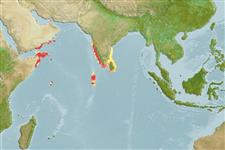>
Scombriformes (Mackerels) >
Trichiuridae (Cutlassfishes) > Aphanopodinae
Etymology: Benthodesmus: Greek, benthos = depth of the sea + Greek, desmos = bond, chain (Ref. 45335).
Environment: milieu / climate zone / depth range / distribution range
Écologie
marin benthopélagique; profondeur 0 - 1000 m (Ref. 6181). Deep-water; 18°N - 3°S, 50°E - 92°E (Ref. 6181)
Indian Ocean: Arabian Sea and Bay of Bengal.
Taille / Poids / Âge
Maturity: Lm ? range ? - ? cm
Max length : 51.0 cm SL mâle / non sexé; (Ref. 6181)
Épines dorsales (Total) : 31 - 34; Rayons mous dorsaux (Total) : 68 - 74; Épines anales: 2; Rayons mous anaux: 64 - 67; Vertèbres: 105 - 109. Body silvery, jaws and opercle blackish. The inside of the mouth and gill cavities black.
Found on seamounts and continental slope from 375 to 600 m, juveniles are mesopelagic from 100 to 300 (1,000) m (Ref. 6181). Minimum depth from Ref. 58018.
Life cycle and mating behavior
Maturities | Reproduction | Spawnings | Egg(s) | Fecundities | Larves
Nakamura, I. and N.V. Parin, 1993. FAO Species Catalogue. Vol. 15. Snake mackerels and cutlassfishes of the world (families Gempylidae and Trichiuridae). An annotated and illustrated catalogue of the snake mackerels, snoeks, escolars, gemfishes, sackfishes, domine, oilfish, cutlassfishes,. scabbardfishes, hairtails, and frostfishes known to date. FAO Fish. Synop. 125(15):136 p. (Ref. 6181)
Statut dans la liste rouge de l'IUCN (Ref. 130435)
Menace pour l'homme
Harmless
Utilisations par l'homme
Outils
Articles particuliers
Télécharger en XML
Sources Internet
Estimates based on models
Preferred temperature (Ref.
123201): 10.8 - 17.5, mean 12.7 °C (based on 22 cells).
Phylogenetic diversity index (Ref.
82804): PD
50 = 0.5005 [Uniqueness, from 0.5 = low to 2.0 = high].
Bayesian length-weight: a=0.00046 (0.00020 - 0.00105), b=3.12 (2.92 - 3.32), in cm total length, based on LWR estimates for this (Sub)family-body shape (Ref.
93245).
Niveau trophique (Ref.
69278): 4.0 ±0.7 se; based on size and trophs of closest relatives
Résilience (Ref.
120179): Faible, temps minimum de doublement de population : 4,5 à 14 années (Assuming tmax>10).
Fishing Vulnerability (Ref.
59153): Moderate vulnerability (45 of 100).
